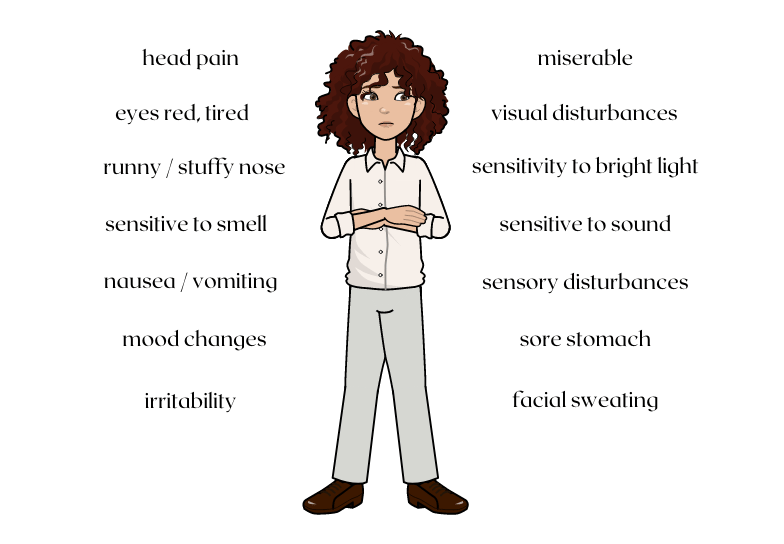My kid has migraine!! What do I do??!
Discusses childhood migraine and how it presents, some of the things to look out for and key tools and tips


Did you know that migraine attacks and headaches are also common in kids as young as 12 months? According to the American Migraine Foundation, half of the children who get migraine attacks have their first attack before the age of 12. interestingly, before puberty and in early childhood, migraine attacks are more common in boys than girls.
Does your child experience headaches including migraine attacks or stress-associated (tension) headaches or abdominal pain? Does anyone else in your family have migraine or regular headaches?
Migraine is a genetic condition; therefore, you must watch out for signs in your kids. Moreover, abdominal pain is one of the first signs of migraine attacks in kids.
It is important to pay attention to your child’s symptoms and consult a doctor if the headache/attack worsens or occurs repeatedly.
Look for symptoms in your kids
Some of the symptoms you may notice could be some of these listed below, or even others not mentioned!
Vomiting and nausea
Sensitivity to sound, light and odor
Sensitivity to motion (for instance travel sickness)
Feel like lying down, sometimes in a dark room
Irritability
Odd depression
Being tired for no reason
Stomach pain/upset stomach
These are common symptoms kids complain of when they experience migraine attacks/headaches. Does your child experience any of the above symptoms along with migraine attacks? How do you spot the symptoms in your child? Sometimes we need to be like private investigators!
Migraine Triggers in Children
Did you know that similar factors trigger migraine attacks in children just as with adults? Although the factors still vary between individuals and the way they experience triggers.
Some of the triggers include:
Sleep
Diet
Dehydration
Stress
Menstruation / hormonal changes
Weather Changes
Medications
Anxiety/Depression
Family History
Have you identified some of the triggers mentioned above in your child? If yes, how have you changed their lifestyle to manage migraine attacks?
Some Differences between Child & Adult Migraine Attacks
According to the American migraine foundation, there are a few key differences in the way children experience migraine attacks.
Some of the differences include:
Less frequent migraine attacks
Migraine attacks are shorter in duration
Experience more bilateral pain compared to unilateral (on both sides, or across the forehead, rather than only on one side)
It is sometimes difficult to tell what is going on with a child because they may have difficulty explaining their symptoms, or they may not know how to describe what they are experiencing. Sometimes it can take clever detective work, as mentioned above!
Open ended questions can be very helpful for parents to start to identify early warning signs, and also to report to your child's medical team. For example, if you want to find out if your child is experiencing visual aura, or disturbance, questions like "how do your eyes feel before or during your head pain starts?" or "what happens with your vision/sight before/during/after your headache?" It can also be helpful to notice if your child is clumsy at particular times, perhaps a day before an attack, or even after, or particularly sensitive to sound, or some other dysfunction.
It is important to pay attention to your child’s symptoms as common symptoms might not be reported.
Do you recognize any of the symptoms mentioned above in your child?
How to Manage Your Child's Migraine Attacks
If your child is experiencing migraine attacks you can make the following measures to reduce the severity of migraine attacks in children:
1. Making lifestyle changes
Did you know that making changes in your child’s lifestyle can help reduce the severity and frequency of migraine attacks?
Some of the lifestyle changes include:
Getting regular sleep every night (8-10 hours daily)
Following a regular sleep routine (ie in bed at the same time every night, then up at the same time each morning)
Physical activity, moderate and regular exercise, however note that sudden exertion can trigger some attacks, some of the time (it's confusing and frustrating to figure this out!)
Healthy and balanced diet
Staying hydrated (drinking 4-8 glasses of water per day)
Keep your child away from smoking
Adjust caffeine consumption
It is important to remember that the lifestyle changes above and some of the tips may not apply to everyone. Therefore, recognize your child’s needs and how each of these changes might affect your child. Have you made any lifestyle changes to reduce migraine attacks in your child? Which changes work best for your child?
2. Stress Management
Did you know that stress may increase the frequency of your child’s migraine attack? Some of the ways you can help manage your child’s stress include:
Encouraging your child to openly share their issues or any stress affecting them
Beware of the factors that may cause stress in your child’s life including:
Difficulty with schoolwork
Strained relationships at home/with peers
Are your child’s migraine attacks associated with depression and anxiety? If yes, make sure to seek help and treatment for your child. What factors lead to stress in your child? How do you help your child deal with stress? What are some of the techniques you use to effectively reduce your child’s stress?
3. Keeping migraine/headache diary
Did you know that you can track information about your child’s migraine attacks in a migraine diary? A diary can help you determine what triggers your child's migraine attacks, but is also useful for tracking what is working and what isn't in terms of management.
Here is some of the information you can keep track of in the migraine diary:
when the headache begins
how long it lasts
what the pain is like
where it hurts.
any other symptoms your child has with the migraine attack
You can also keep track of things that relieve your child’s migraine attacks, medications/complimentary medicine and if they're making a difference
All these measures will help you in understand your child’s symptoms, record their triggers and facilitate in taking specific preventive measures. If you keep a migraine diary, how effective has it been in identifying your child’s symptoms & patterns? Are there other ways you record information about your child’s migraine attacks? Please contact me if you want a suggestion about apps that help you with these records (or do a search in your app store "migraine diary", "migraine tracker".
4. Following doctor’s plan
Did you know that the doctor may prescribe medication to your child if they are experiencing severe or regular migraine attacks? Ensure that your child follows the routine of the prescribed medication and takes the medication at regular intervals to reduce the severity and frequency of your child’s migraine attacks.
Some of these preventive medications include:
Vitamins and Minerals, which are often tried first, before other medication
Antidepressants
Anti-seizure medications
Beta-blockers
Antiemetics or Gravol (to help reduce nausea)
Did you know that painkillers such as children’s ibuprofen or acetaminophen can help reduce the pain of your child’s headaches? However, take caution when giving painkillers to your child as for some kids it can result in more headaches. In addition, any NSAID or over-the-counter medication may result in more headaches if used too regularly. Please consult with your doctor.
Have you ever given your child painkillers or any other preventive medications? Are they cost-efficient? Have they effectively reduced pain or severity and frequency of migraine attacks in your child?
5. Home treatment measures
Did you know that you can take specific measures at home when you observe the first sign of a migraine attack in your child?
Some of these measures include:
Asking your child to relax in a quiet and dark place at home
Ask them to avoid electronics or reading during migraine attacks
Gently Massage your child’s neck and shoulders, if your child can tolerate it
Place a heating pad or cooling pad on your child’s head. However, always ask what your child prefers first as sometimes heat can worsen the pain
Place a wet and cool cloth on your child’s forehead or the head parts that hurt.
If your child isn’t old enough to let you know, avoid any scents as they can trigger migraine attacks in many kids.
Some kids want a soothing bath with a few drops of lavender oil or Epsom Salts to calm them down. However, again always ask what they prefer and if they can tolerate it.
Lavender oil diffuser can also be soothing as it is safe and gentle, however make sure the smell doesn't make your child feel unwell
6. Seeing or visiting doctor
Do you notice your child’s migraine attacks getting worse? Has the frequency and severity of your child’s migraine attacks increased? If so, it may be helpful to get a referral from your family doctor or GP to see a headache/migraine specialist to get the best treatment for your child.
Some of the treatment options include:
Acute treatment, which stop attacks from getting worse
Preemptive Treatment, which is used when the trigger for your child's migraine is known
Preventive Treatment, taken every day to:
Reduce the frequency, severity, and duration of migraine attacks
Lessen the pain over a period of months and years
Non-medical approaches are complementary to medical treatment to reduce pain. Did you know that these treatments are now considered complementary and integrative treatments?
Did your child use any of the treatment options above? How effective has medical treatment been to reduce the severity and frequency of your child’s migraine attacks?
Kids cannot always accurately describe what they are experiencing or their symptoms. Therefore, it is imperative for you as a parent to monitor and track your child’s migraine attacks and take the appropriate measures as required. Are there any other ways that you manage your child’s migraine attacks? How effective have these techniques been to reduce the severity and frequency of your child’s migraine attacks?

